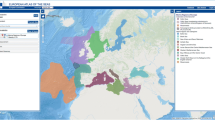Abstract
Spatial features are important properties with respect to data integration in many areas such as ocean observational information and environmental decision making. In order to address the needs of these applications, we have to represent and reason about the spatial relevance of various data sources. In the paper, we develop a qualitative spatial representation and reasoning framework to facilitate data retrieval and integration of spatial-related data from ocean observational systems, such as in situ observational stations in the Gulf of Mexico. In addition to adopt the state-of-the-art techniques to represent partonomic, distance, and topological relations, we develop a probability-based heuristic method to uniquely infer directional relations between indirectly connected points. The experimental results show that the proposed method can achieve the overall adjusted correct ratio of 87.7% by combining qualitative distance and directional relations.
Research is supported in part by the National Science Foundation under grant CNS-0708596 and CNS-0708573.
Preview
Unable to display preview. Download preview PDF.
Similar content being viewed by others
References
de Berg, M., van Kreveld, M., Overmars, M., Schwarzkopf, O.: Computational Geometry: Algorithms and Applications. Springer, Heidelberg (2000)
Cohn, A.G., Renz, J.: Qualitative spatial representation and reasoning. In: Handbook of Knowledge Representation. Elsevier, Amsterdam (2008)
Dehak, S., Bloch, I., Maitre, H.: Spatial reasoning with incomplete information on relative positioning. IEEE Trans. on Pattern Analysis and Machine Intelligence 27(9), 1473–1484 (2005)
Duckham, M., Lingham, J., Mason, K., Worboys, M.: Qualitative reasoning about consistency in geographic information. Information Sciences 176(6), 601–627 (2006)
Frank, A.: Qualitative Spatial Reasoning: Cardinal Directions as an Example. Twenty Years of the Intel. Journal of Geographical Information Science and Systems (2006)
Gabriel, K.R., Sokal, R.R.: A new statistical approach to geographic variation analysis. Systematic Zoology 18, 259–270 (1969)
Haarslev, V., Lutz, C., Moeller, R.: Foundations of spatioterminological reasoning with description logics. In: Principles of Knowledge Representation and Reasoning (1998)
Jaromczyk, J.W., Toussaint, G.T.: Relative neighborhood graphs and their relatives. Proc. IEEE 80(9), 1502–1517 (1992)
Ligozat, G.: Reasoning about cardinal directions. Journal of Visual Languages and Computing 9, 23–44 (1998)
Liu, Y., Zhang, Y., Gao, Y.: GNet: a generalized network model and its applications in qualitative spatial reasoning. Information Sciences 178(9), 2163–2175 (2008)
Schlieder, C., Vogele, T., Visser, U.: Qualitative spatial representation for information retrieval by gazetteers. In: Montello, D.R. (ed.) COSIT 2001. LNCS, vol. 2205, p. 336. Springer, Heidelberg (2001)
Stuckenschmidt, H., Harmelen, F.V.: Information Sharing on the Semantic Web. Springer, Heidelberg (2004)
Toussaint, G.T.: The relative neighborhood graph of a finite planar set. Pattern Recognition 12, 261–268 (1980)
Visser, U.: Intelligent Information Integration for the Semantic Web. LNCS, vol. 3159. Springer, Heidelberg (2004)
Author information
Authors and Affiliations
Editor information
Editors and Affiliations
Rights and permissions
Copyright information
© 2009 Springer-Verlag Berlin Heidelberg
About this paper
Cite this paper
Li, L., Liu, Y., Nalluri, A.K., Jin, C. (2009). Qualitative Spatial Representation and Reasoning for Data Integration of Ocean Observational Systems. In: Li, Q., Feng, L., Pei, J., Wang, S.X., Zhou, X., Zhu, QM. (eds) Advances in Data and Web Management. APWeb WAIM 2009 2009. Lecture Notes in Computer Science, vol 5446. Springer, Berlin, Heidelberg. https://doi.org/10.1007/978-3-642-00672-2_37
Download citation
DOI: https://doi.org/10.1007/978-3-642-00672-2_37
Publisher Name: Springer, Berlin, Heidelberg
Print ISBN: 978-3-642-00671-5
Online ISBN: 978-3-642-00672-2
eBook Packages: Computer ScienceComputer Science (R0)




